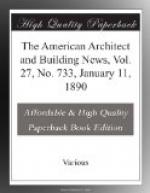“It is an uncommon thing to find, as in this instance we do, the nave only of a church remaining, for the chancel was generally the part first erected, and sometimes the only part. The remains of the central and eastern portions of St. Machar’s tell how the western compartment braved the causes of destruction which to them had been fatal: they were built of freestone. Incrusted, as it were, in the eastern wall, are the clustered freestone pillars, with richly-flowered capitals, which of old supported the central square tower; and on either side are the vestiges of the transept, with the remains of the richly-sculptured tombs, represented in the accompanying plate, embedded in the wall. In Slezer’s, and some other representations of this building in the seventeenth century, the tower—a simple square mass, with a roof—appears to have been still standing, but the choir had disappeared.”
MONUMENT IN THE SOUTH TRANSEPT OF THE CATHEDRAL, ABERDEEN, SCOTLAND.
THE HOTEL DE SOTO, SAVANNAH, GA. MR. WM. GIBBONS PRESTON, ARCHITECT, BOSTON, MASS.
This hotel, which has just been completed, occupies a whole square in the heart of the city, and has a frontage of 300 feet on Liberty Street and 200 feet on Bull Street. It forms two sides of the square, the two-story kitchen and servants’ wing forming the third side. The climate renders it desirable to have it freely open and exposed to the cool southeast winds which blow refreshingly up from the bay, and, as a winter resort, a southeast exposure of nearly




